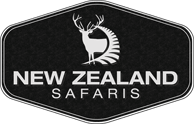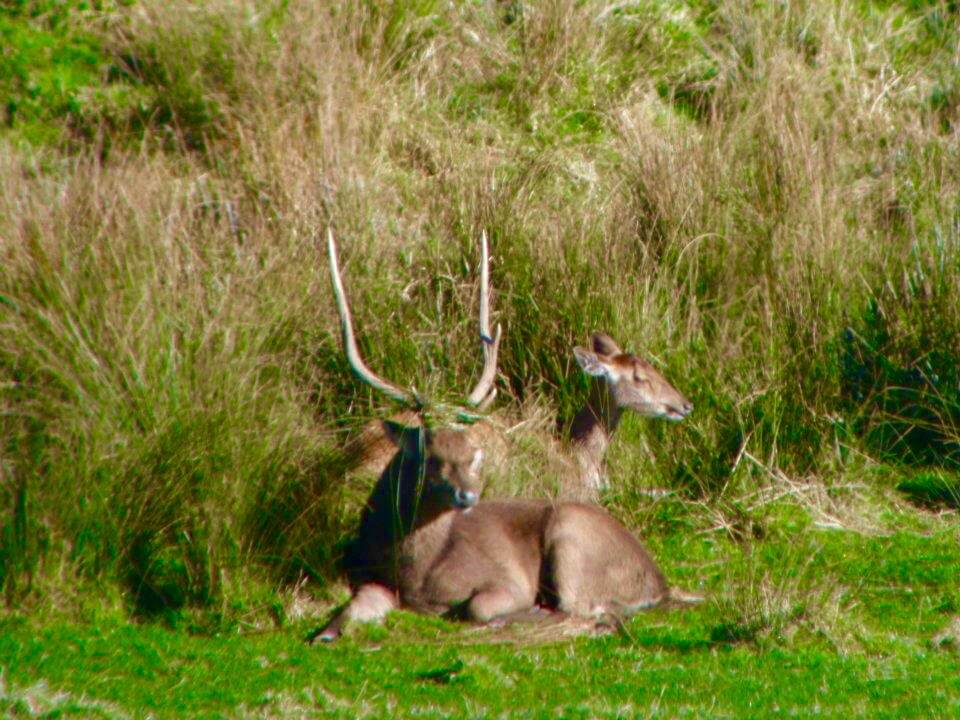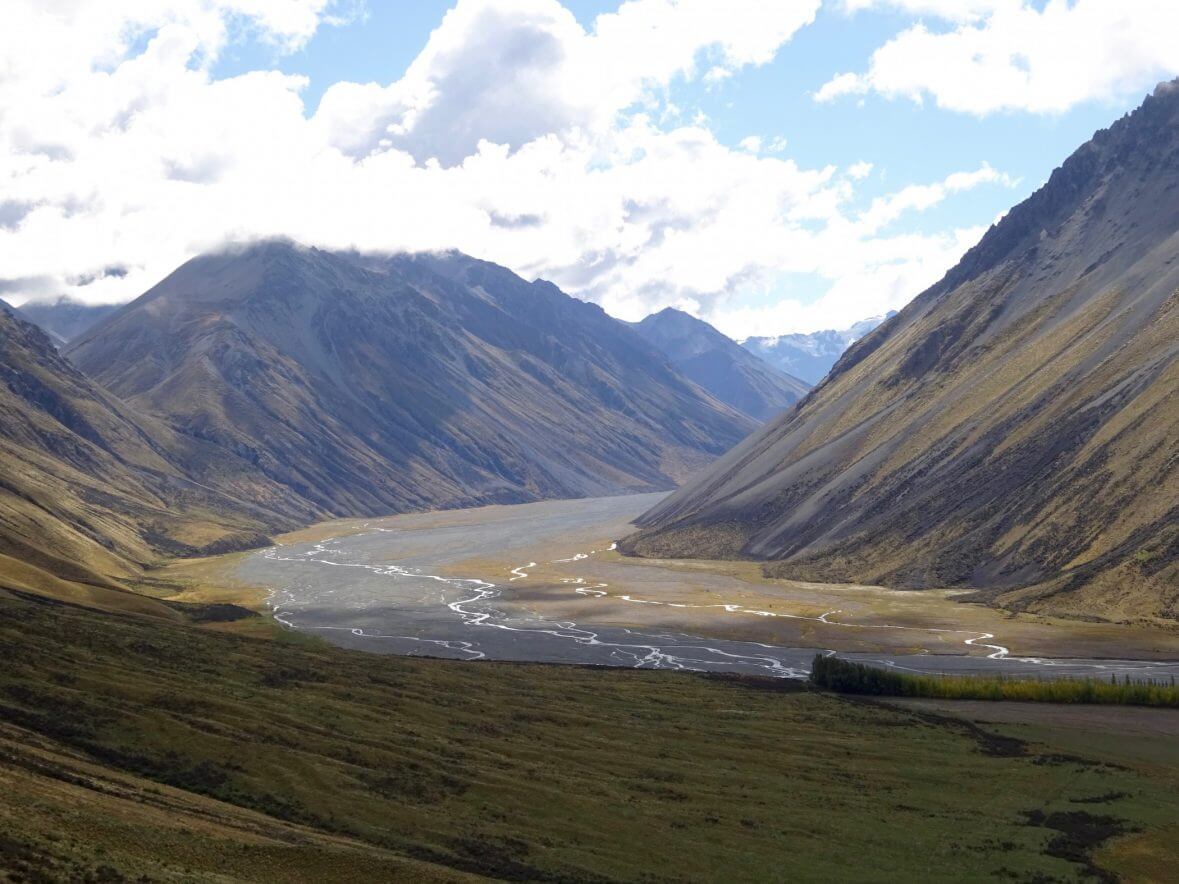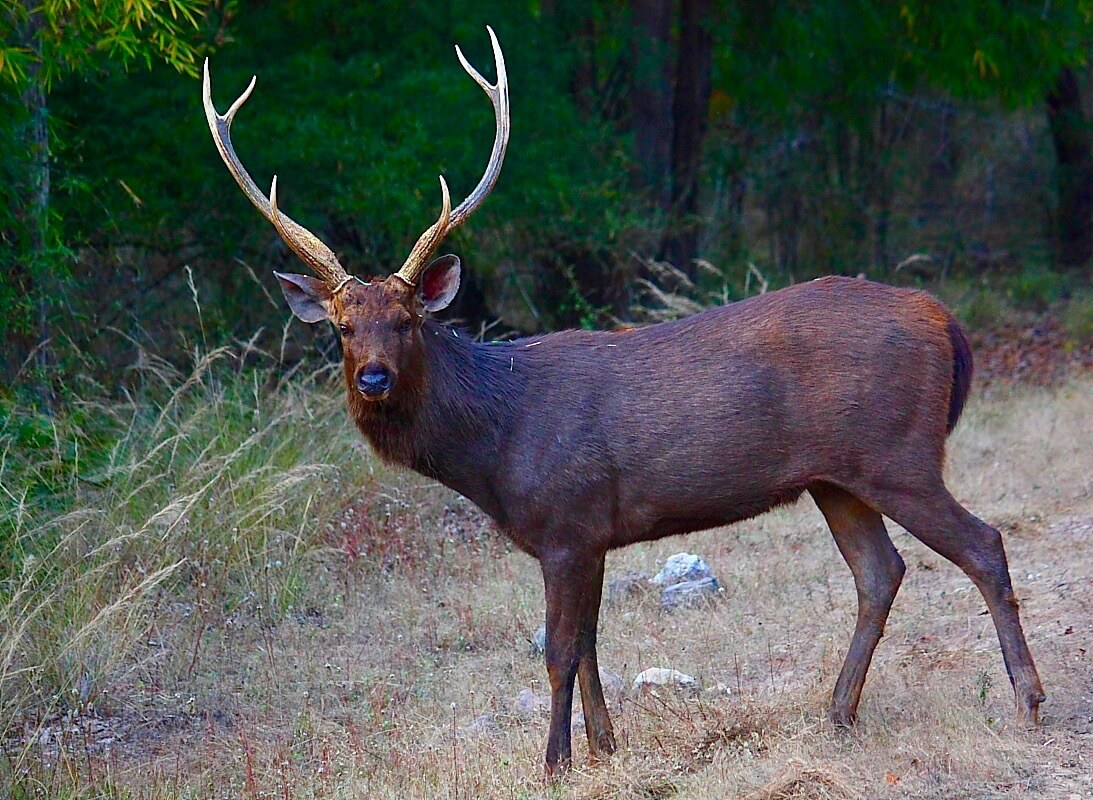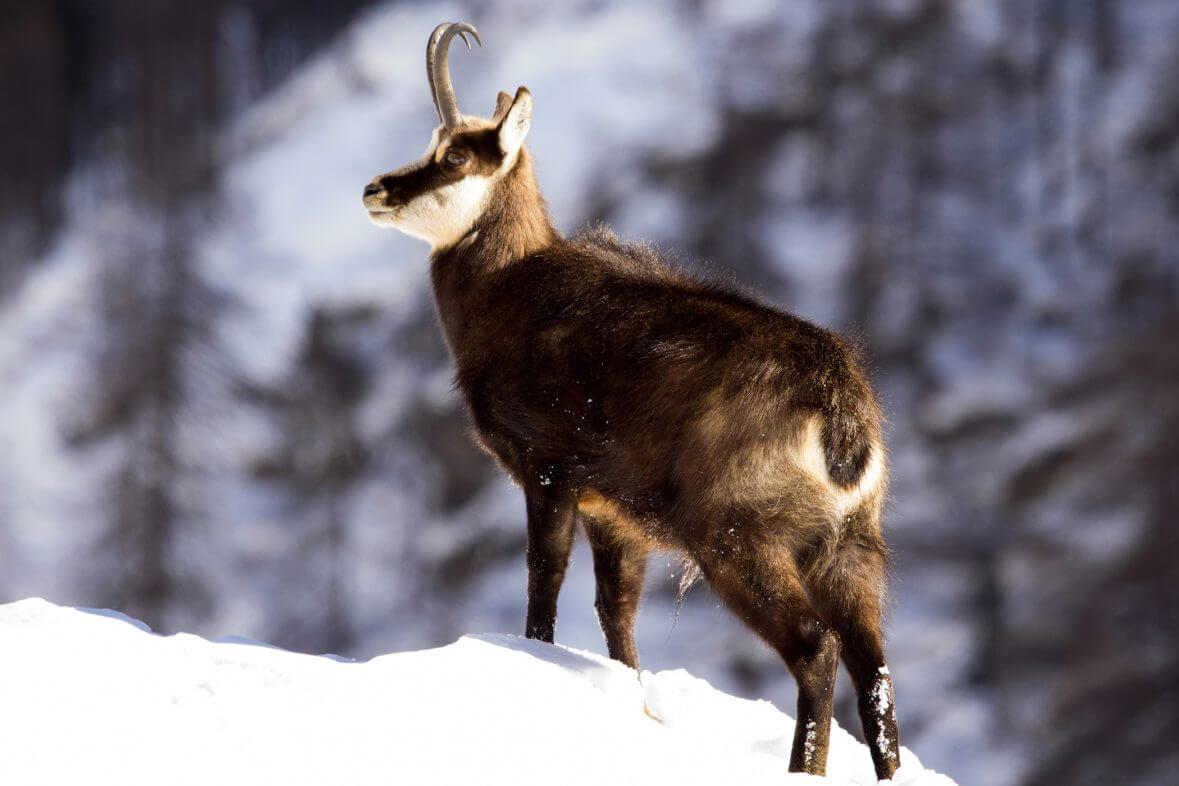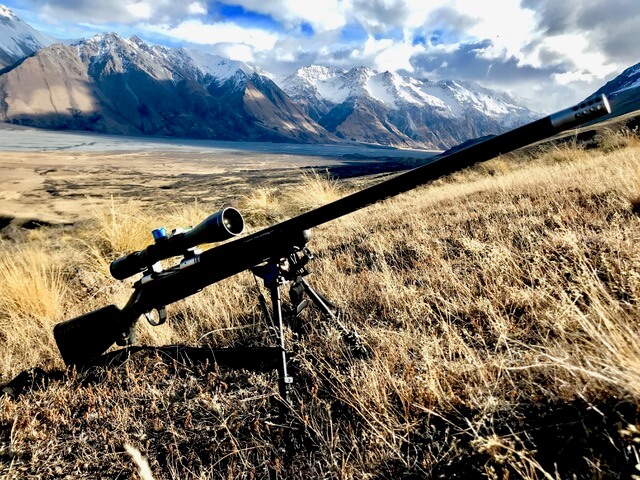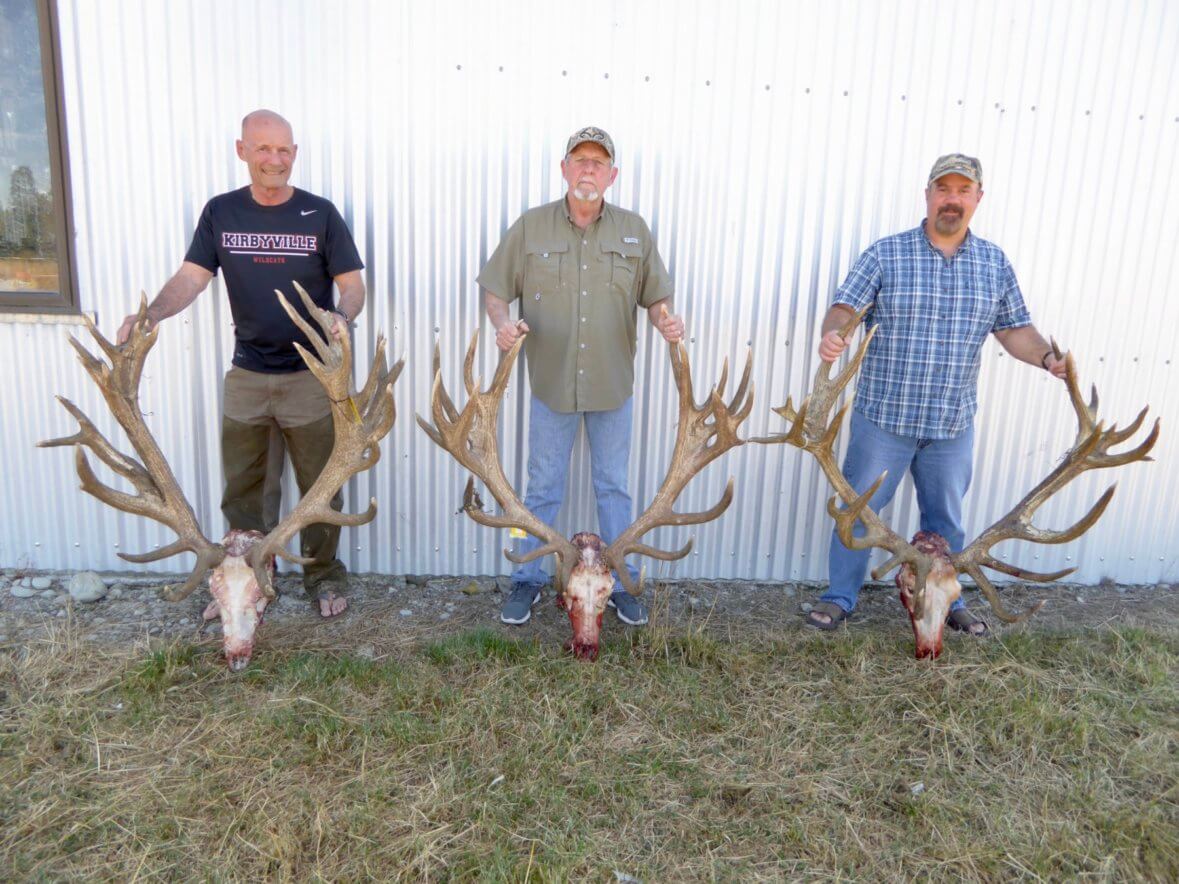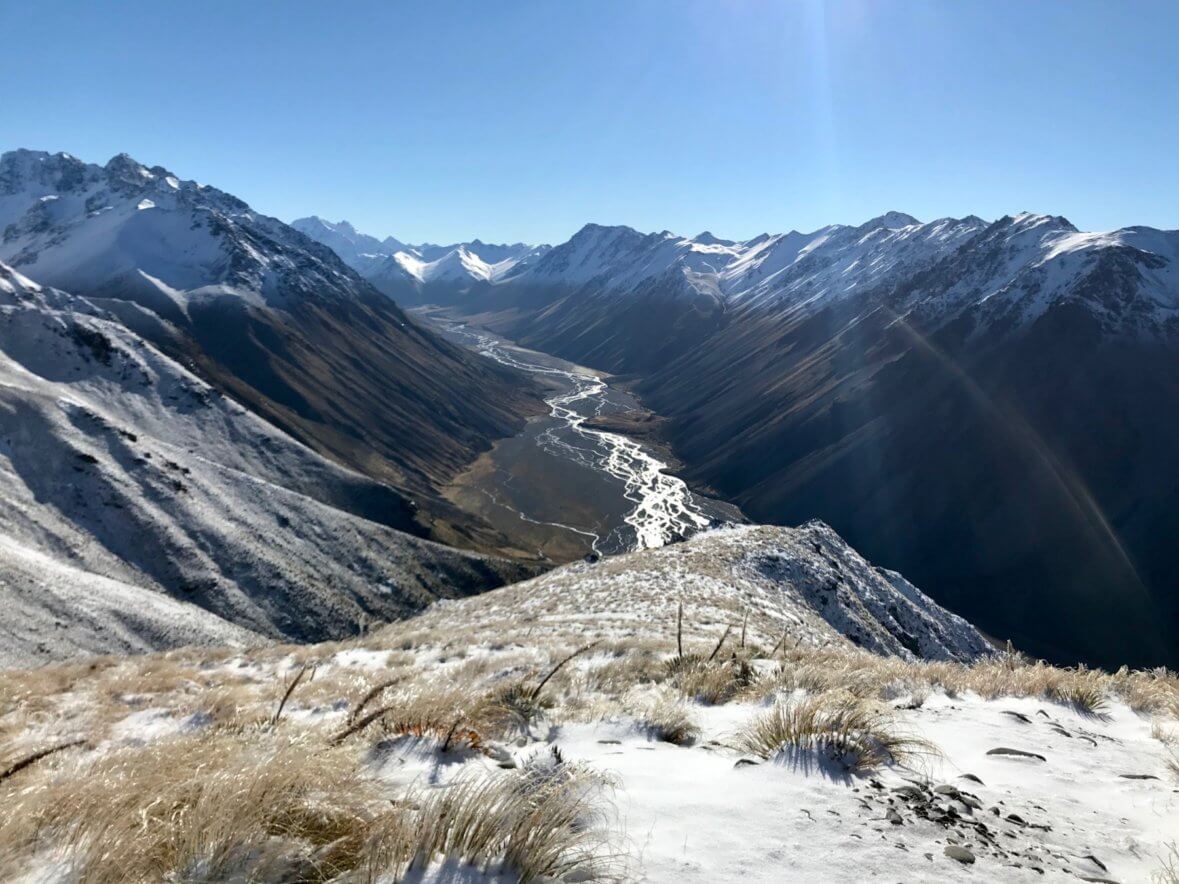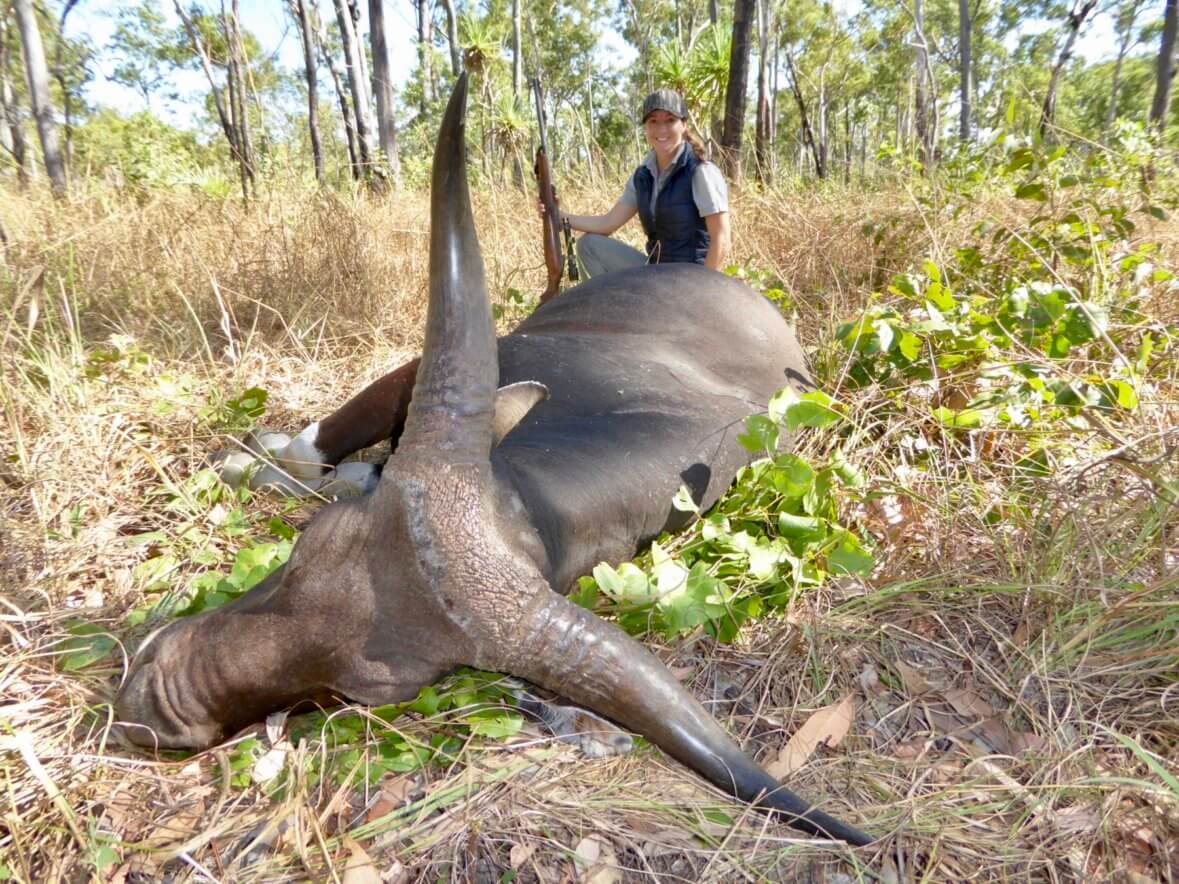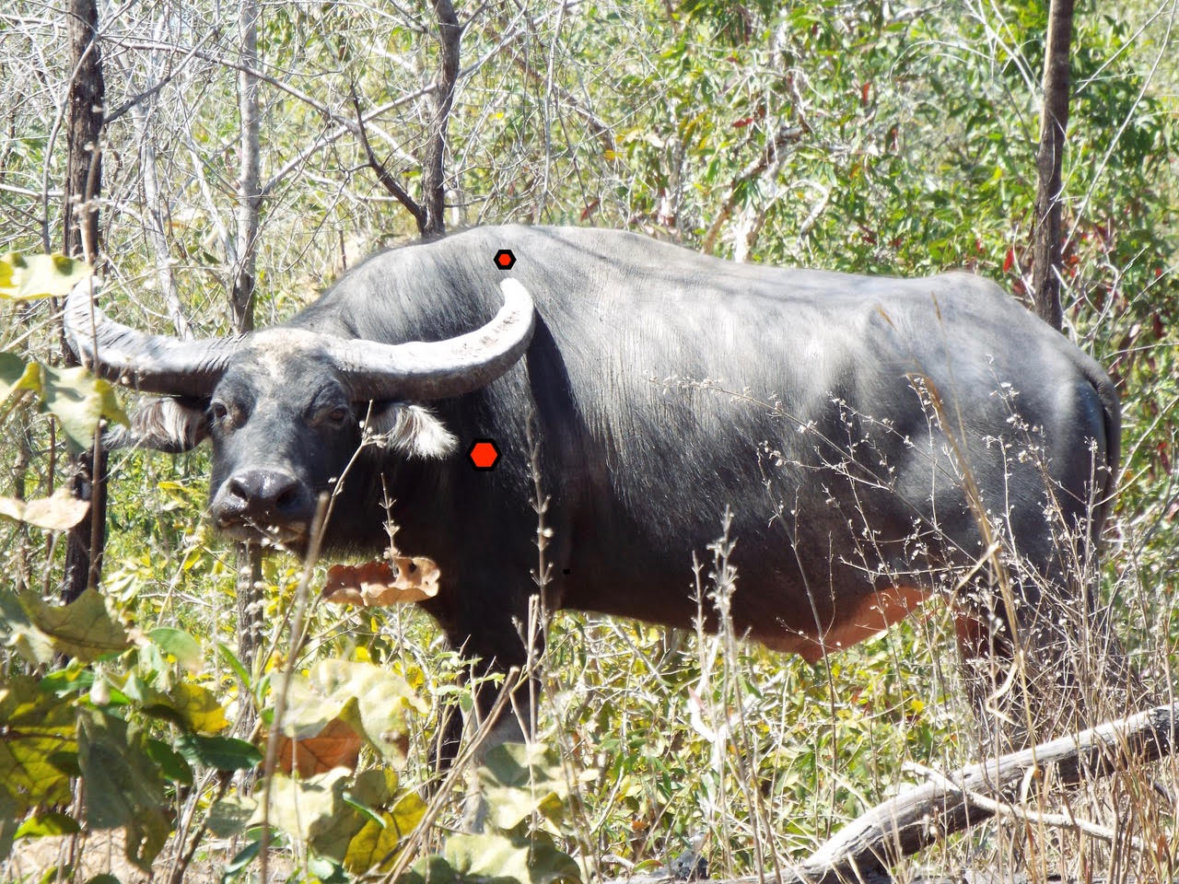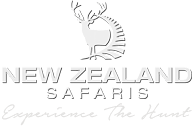A rusa deer (Rusa timorensis) is one of the most elusive deer to be found in the New Zealand bush. New Zealand Safaris offers rusa deer hunts in both New Zealand and Australia.
Description
Size: Male height is about 1060 mm at the shoulder and weighing 122 kg, females 810 mm shoulder height and weighing up to 70 kg.
Colour: Males dark reddish-brown summer coat changing to dark greyish-brown in autumn. Females pale yellowish-red in summer and greyish-red in winter. Chin, throat and underparts cream.
Antlers: Present in males only. Antlers cast December-January and new growth complete by May. Normally 3 points on each antler, with the inner tine longer than the outer and nearly parallel with the inner tine of the other antler.
Social behaviour: Wary and semi-nocturnal rusa spend much of the day holed up in thick vegetation cover. They live in small groups and have relatively small home ranges. Prefer mixed grass areas for feeding and often utilise adjacent farm paddocks and crops.
Reproduction: Rut commences mid-July and continues into August.
Males collect a harem of females. The actual male rusa’s roar could be described as a short husky growl rather than the drawn out bellow of a red stag. Males roar infrequently perhaps only 2-3 times a day with concentrated activity early morning and late afternoon.
Males wallow and mark their territory with scrapes. While servicing these scrapes, males leave an unmistakeable scent that could be described as a pungent sickly sweet aroma.
Gestation period: About 240 days.
Birthing: Fawns are born March – April. Twins rare.
Nomenclature: Male = stag. Female = hind. Young = fawn/calf.
Hunting Tips:
| Characteristics/behaviour | Hunting response |
|---|---|
| Rusa are a medium sized deer. | Rifle ccalibre of .270and above are suitable for shooting rusa deer. |
| Occupy areas of thick cover with warm aspect and adjacent to open grazing areas. | Seek out suitable habitat and either:Hunt very slowly, stopping often to look around as rusa are often very hard to see amongst dense vegetation.Stake out a warm clearing (especially in winter) and wait for a deer to come to feed, often involves a long shot. (Probably the more successful method.) |
| Semi-nocturnal and active mainly early morning and late afternoon, lay up in thick cover during much of the day. | Hunt or be at the stake out location early morning or late afternoon when deer likely to be more active. Rusa Stags rut from June-October. |
| Rusa are rarely encountered on their own. | When a rusa is sighted be alert as others may be in close proximity but hidden from view. |
| Sign of rusa includes a network of well used trails and tunnels connecting bedding sites with feeding areas. | Stake out areas where recently used tracking systems are found accessing feeding areas. |
DIY hunting or hunting without a guide in New Zealand is always an option. The major difference you will find in hunting on public land on your own versus private land with a guide is in the game management or more specifically the lack of game management. On most government land there is no season so animals get hunted all year round by residents and DIY New Zealand hunters which naturally forces them to live in steep and inaccessible areas. These areas will have very low quality of food due but the hunting pressure forces them them.
Helicopter hunting is also very common on government land, this means that at any stage during a hunt on public land helicopters can and will come through your area especially for Tahr & Chamois.
All of the private land that New Zealand Safaris hunts on is managed, helicopters are prohibited and we hold the exclusive hunting rights. The game animals on these properties have a value and are respected. These private properties are huge, averaging between 15,000-40,000 acres of mountain to hill country. Each mature trophy animal that is harvested is paid for (many thousands of dollars) directly to the land owners. This then means that animals are not over shot without value as opposed to government land.
Less hunting pressure, better quality feeding areas, animals get a chance to grow old and big which then creates superior genetics. Hunters with a tight budget and more interested in shooting an animal of any size of sex and where age is not important will be more suited to DIY New Zealand hunting.
In New Zealand, sambar deer (Cervus unicolor unicolor) are considered an ‘iconic herd’. They are only in the North Island and mostly on private land.
Sambar can be a difficult deer to hunt. As with all hunting the more you can learn about the quarry and the area to be hunted the better the chance of success.
Description:
Size: Males average 1370 mm shoulder height and 245 kg in weight with females smaller at 1150 mm shoulder height and weighing up to 157 kg.
Colour: Uniform brown darkening to almost black in older animals with tan to rust red on the rump. Under parts grey to mid brown.
Antlers: Thick, heavily pearled and normally three tined (brow and trez tines and a terminal tine at the end of the main beam). Antlers cast November to December with new ones grown January to March hardening between June and November.
Social behaviour: Males solitary except during the rut. Young males and females form small groups of 2-5 animals. Feed mainly at night and during the day seek shelter in scrub or forest cover. Form complex trail systems accessing feeding areas from day time cover
Reproduction: The rut can happen any time between late May and December with June to August the usual period. The females, attracted by noise and scent, visit the male for a short period until mating takes place. (Harems are not formed.) Males are not particularly vocal during the rut but are known to emit a short harsh belling noise which is rarely heard by hunters.
Gestation period: Approximately 240- 264 days.
Birthing: March-April or July-September.
Nomenclature: Male = stags. Female = hind. Young = fawn/calf.
Where to hunt
In New Zealand sambar deer are only found in the North Island.
The two main populations of wild sambar deer are found in the Manawatu/Wanganui region and the Bay of Plenty region. Their range in both these areas is mostly on private land – mainly forestry blocks. New Zealand Safaris has exclusive hunting access to some of the most sought after sambar deer properties in the country.
Sambar occupy a variety of habitats from indigenous and exotic forests to wetlands and farmland.
Hunting Tips:
| Characteristic/behaviour | Hunting response |
|---|---|
| Large bodied animals (mature stag 400-500 llb andstand 60+ inches at the shoulder) | A larger rifle calibre with high energy is recommended with Sambar Stags deer known to absorbed shots. Suitable calibers include .270, 7mm, 300 win. |
| Although tending to be unpredictable, within a hunting area sambar will have preferred spots for feeding, hiding etc. | Learning as much as you can about the area being hunted will greatly increase the chances of success. |
| Elusive animals with the ability to exit within close proximity to people without being detected. Often won’t break until a hunter is very close and sometimes crawl rather than run. Can hide in very small patches of vegetation. | Hunt slowly, stopping often and surveying all around. Don’t discount the smallest of vegetation patches eg small clumps of gorse. |
| Once spooked sambar usually won’t go far and as retreating can often be heard making a trumpet like noise. | Listen to retreating animal to gauge where it is heading and after a short time follow. |
| Sambar feed primarily early morning and late evening utilising the cover of darkness but can be found feeding during the day using vegetation cover. | Late evening and early morning hunting is likely to find deer out in the open where as day time hunting will likely find deer in amongst thick vegetation. Hunt the change of light on dark nights. |
| Sambar are attracted to crops for feeding. | New Zealand Safaris hunts exclusively on private free ranging land like that has this feed. |
| Sambar Deer Rut New Zealand | Sambar deer’s main rut is from late May-September, and at times longer. |
| Sambar are very alert to foreign sounds. | With the wind in the right direction stake out feedings areas and wait for sambar to come to you. |
Chamois (Rupicapra rupicapra rupicapra) are found throughout the high country of the South Island and in some lowland forests, from the Marlborough Sounds in the north to Fiordland in the south.
They are renowned for their ability to occupy a range of mountain habitats, and will spread into lower altitude forest areas especially on the West Coast.
Description
Size: Males Bucks are 650-900 mm (shoulder height) and weigh 55-100 lb. Females are smaller at 600-800 mm shoulder height and weighing 41-55 lbs.
Colour: Their summer coat varies from grey-brown, tan to honey-gold tone. Their much darker winter coat is dark brown/almost black.
On their face they have a dark brown or black band that goes from the nose, around the eyes to base of horns. Their cheeks and throat are white or pale fawn.
Horns: Both male and females have horns which are black and slender. They arise straight up before curving backwards to form sharp hooks at the ends. Male horns are usually stouter and their hooks more strongly developed than females.
Social behaviour: Mostly feeding during the day, during summer time they feed for 3-4 hours from dawn and again for 3-4 hours before dusk. They rest during the middle of the day. During winter they feed less intensively, mostly at mid morning and mid afternoon.
Outside of mating season, male and female chamois are largely segregated. Females and young form loose, unstable groups, and males are mostly solitary.
Reproduction: Mating season begins in early-mid May, peaking in late May to early June. During this time dominant males will gather available females in a harem, defending them from other males often posturing with imposing displays but rarely resulting in frontal attacks.
Gestation period: Variable 5 1/2 to 6 months.
Birthing: Single young are born from November to February.
Nomenclature: Male chamois are called bucks, females called doe, and there young called kids.
Where to hunt chamois
Chamois are found throughout the high country of the South Island and in some lowland forests, from the Marlborough Sounds in the north to Fiordland in the south.
They are renowned for their ability to occupy a range of mountain habitats, and will spread into lower altitude forest areas especially on the West Coast. New Zealand Safaris has exclusive hunting access to private land areas which do not require the use of helicopters. Beaches these areas and managed with a maximum of 2 Bucks per property there are very good numbers and older animals with no pressure from local hunters.
The right rifle caliber for hunting in New Zealand is wide open, that is like asking what kind of truck do you like to drive, or beer do you drink. New Zealand Safaris tested the latest Christensen Arms Ridgeline out for the 2019 season in 7mm mag using Hornady hand loaded 175g ELD-X.
We typically shoot at distances between 200-400 yards depending on clients confidence, animals, weather, ect. These longer shots are more taken on our free ranging and wild animals such as Red Stag, Tahr, Chamois, Sambar Stag and Fallow Buck. Red Stag, Tahr and Sambar Stag are extremely heavy boned with thick hides especially the Tahr so suitable rifle caliber for hunting in New Zealand must be able to deliver the energy down range with precision accuracy for fatal shot placement.
We now have more demand from clients to use our rifles so lighter in weight has become more important, as we also have a bipod on the front of the rifle and often suppressors to take recoil and reduce the noise. All of our hunting is on private land so we like to manage the habitat for the game to help get our clients onto those older mature animals. Obviously that is unique to our private land properties, you will not find that on government land where animals are constantly getting shot at or from above by way of helicopters.
We used the Christensen Arms Ridgeline rifle on one hunt that included 3 animals in winter so all the coats were heavy. The longest shot was a free ranging Chamois, or mountain Antelope. These are by no means heavy skinned but very small in size with an up hill shot at 370 yards the Hornady Bullets held together perfectly and the shot was fatal instantly and made very little damage to the hide.
The Tahr also was 365 yards as the hunter had confidence in this rifle and we had zero wind, on a cooler winter morning we were shooting across from one ridge to another. Although the animal ran out of sight it fell some 60 yards behind the ridge with the bullet lodging out the outer side just under the heavy skin.
The Red Stag was 320 yards and in an opening of heavy timber. With light weight rifles like the Ridgeline you can move about more freely as every pound counts on mountain hunts. The quartering shot went in behind the front shoulder and exited on the inside front should, the stag stood briefly with a second shot as insurance it was over.
After using a variety of bullets such as Berger, Barnes and sSwift I have found the latest Hornady 175g projectiles to be well suited all round for our game. This was the first Christensen Arms rifle we have owned and we’re very impressed with its performance. Topped with a Huskemaw Optics Dial Scope this is a great fit for our New Zealand Safaris clients.
A Tahr (Hemitragus jemlahicus) are large goat-like animals, native to the central Himalayan ranges of India and Nepal. In New Zealand tahr are found in the central Southern Alps between about the Rakaia and Whitcombe valleys in the north to about Lake Hawea in the south. The main population today of Tahr still exist around the Mt Cook area in the central South Island.
Tahr are also known as and called Himalayan Tahr. Tahr are originally from Nepal they were gifted to New Zealand over 100 years ago for sport They have found the Southern Alps of the South Island ideal habitat. The Himalayan Tahr was introduced to the central South Island of New Zealand. Specifically the Mt Cook area which also happens to be the home of New Zealand Safaris.
Tahr are generally found in the alpine grassland zone, where they graze on snow tussocks, alpine herbs and sub-alpine shrub-land plants.
The male tahr’s summer coat is a reddish-brown, females a medium brown, both turning dark brown in winter. The bull tahr has an impressive mane of long hair around the neck and shoulders.
Tahr are popular with recreational and international hunters for their horns, the male’s striking mane, and for the experience of this mountain like goat hunt.
Tahr are social animals and form easily recognisable groups. Adult females, yearlings and kids gather together, males over 4 years form bachelor groups, and younger males hang out together in separate, smaller groups. Males mix in with the females in their range over the winter breeding season but during the summer months they often travel long distances away from the female groups. A mature male is considered 6 years or older which you can count by his rings on his horns which is a trophy Bull. Tahr can be hunted both on government land or private land. With the culling operations that are presently happening hunters after a quality experience have now learnt that private land is far more successful in taking mature trophy Bulls with a recognised outfitter like New Zealand Safaris, over hunting against other hunters and helicopters on public lands in the same areas.
A male Bull Tahr can weigh up to 300 pounds and will hold up to 50 nannies and kids during the rut. The tahr rut normally happens in May-July. Bull Tahr will get older and will have longer horn growth when then inhabit privately owned, free range areas where the hunting is well managed. These animals have the ability to come down to lower areas to feed on sweet grasses unlike the tahr you will find on public or government land.
Today Tahr are found along the Southern Alps of the South Island but more specifically centralised in the middle part of the South Island still today in the Mt Cook, Mackenzie region.
One of the most common questions we hear is, how much is a red stag hunt in New Zealand? There are lots of factors that will effect the price of a red stag hunt – public or private land, professional outfitter or DIY, size of the animal, accommodations to name a few. Most Red Stag hunts with professional outfitters will start around USD $5500 per hunter in 2 hunters x 1 guide. This will often include 5 days of hunting, 4 nights of accommodation and trophy fees for 1 Red Stag up to 350 inches or 1 wild and free range Red Stag.
So how much is a red stag hunt at At New Zealand Safaris? Our base Red Stag hunts starts at $5500 which is conducted all on privately owned land, where we have exclusive hunting rights.
As you research you will find Red Stag hunt prices in New Zealand can vary depending on the hunting outfitter and quality and experience of the hunt someone is looking for.
If you are interested in larger stags or combination packages please contact us.
About one third of the total land area in New Zealand is public land, that mostly can be hunted. When hunting on public land you will need to have a D.O.C permit, and a New Zealand Firearms permit. A lot of the public hunting areas in New Zealand has no management or restrictions at all, which means the animals can be and are hunted year round. Over the years, this lack of management has affected the quality of trophy heads, the habitat, and characteristics of the animals. Most often we see these animals becoming nocturnal and very spooky. You will especially notice the differences within the red deer population. A red deer taken on public land usually has a noticeable difference and lack in quality compared to that of private land hunting.
So where can you hunt in New Zealand? Some of the animals are only in one island, or will only be within certain areas of the islands. It is important to figure out exactly what species you are after and then you can figure out exactly where in New Zealand you should be hunting according to the species you are after,
North Island Species
In the North Island species to hunt are predominantly deer; Red deer, Sika deer, Sambar deer, Fallow deer, Rusa deer. You will also find Goats, and birds.
South Island Species
In the South Island species to hunt are Red deer, Fallow deer, Elk, Whitetail deer, Tahr, Chamois, Wild Ram, Alpine Goat, Wallaby, and birds. Again many of these species are more prominent in some areas. For example, Tahr, which are mainly in the central South Island near Mt Cook.
New Zealand Safaris offers free range and fair chase hunting opportunities. Our lodge is located in the South Island but we arrange hunting safaris in the South Island, North Island and Australia. If you are considering taking a hunting trip to New Zealand investigate all of your options before determining where to hunt in New Zealand.
In August, you’ll find us up in the the remote parts of the Northern Territories of Australia on Australian big game hunting safaris for Banteng, Buffalo, boar and for added fun fishing and cultural tours.
With already two huge Banteng Bulls down to start our 2019 Australia Big Game Safaris over here these are the most elusive large animals you can hunt acting more like a deer than bovine. Completely wild and free ranging we have permits in conjunction with the traditional land owner Soleman Cooper to hunt the highly coveted Garig Gunak Barlu National Park where the last of the pure Banteng exists that have not crossed with cattle and first introduced and still roam wild and free due to heavily managed hunting.
With warm temps these huge animals feed on the burns late evenings and leave them early in the mornings spending the day near fresh water springs in heavy tropical jungle and trees, which makes this hunt even more exciting as they will blow loudly through their nostrils right beside you before dissolving into the grasses. Amazingly exciting we also encounter Water Buffalo, Boar, Wild Horses and at times donkeys.
The ocean fishing is second to none off the rocks of beaches as there is little to no fishing pressure, but swimming is not advisable as there are a couple of aquatic species that have reasonably sharp teeth.
Combine all this to have the traditional aboriginal owner with us talking about his ancestors or hunting methods and tracking these animals in areas where the average white guy would need a GPS this is just one of those hunts that is very pure, exciting, and memorable on many levels. Camp is both comfortable and adequate, we bring our own fresh food and alcohol in with a cook on the beach front cabins which has generator power, flushing toilet and running water/ showering and private bed rooms for this remote location this is perfect place to have thousands of acres to yourself.
Australian Water Buffalo are an amazingly tough animal, underestimated and under gunned by many.
A Bull in his prime will be 600-800 lbs heavier than his cousin the African Cape Buffalo, the Australian Water Buffalo is also about 2-2.5 ft taller with a much denser bone structure. A mature Australian Water Buffalo is 16 plus years, it is not uncommon to take Bulls that are 20 years or older if they are in a wild and free ranging environment like the one in this video.
To make an ethical shot on an Australian Water Buffalo Bull it is recommended to use a minimum of .375 caliber although some hunters may use a .338. On our Australian Water Buffalo hunts we have seen that the .338 caliber is moving much too quickly to achieve maximum expansion of projectile which should be bonded, or, first shot even a solid but this can be left to the experts to discuss in depth.
Taking risky or 50/50 shots is strongly discouraged as a wounded Australian Water Buffalo will be either lost or create a dangerous situation. Taking time to stalk and wait until an almost 90 degree shot is possible and is the best practice. Half way from top of the shoulder to bottom of chest and straight up from the front leg, or if the offset shoulder is slightly forward/behind then centred between the two which should break both shoulders, lungs, and potentially heart.
Depending on the follow up shot (99% of the time a follow up shot is needed) and his position, then the shot should be into the same spot or high neck/spine shot if possible.
